What's inside
What's inside
 Key Ingredients
Key Ingredients

 Benefits
Benefits

 Concerns
Concerns

 Ingredients Side-by-side
Ingredients Side-by-side

Caprylic/Capric Triglyceride
MaskingCetyl Ethylhexanoate
EmollientIsononyl Isononanoate
EmollientPEG-7 Glyceryl Cocoate
EmulsifyingIsopropyl Myristate
EmollientSimmondsia Chinensis Seed Oil
EmollientGlycine Soja Oil
EmollientSesamum Indicum Seed Oil
EmollientRibes Nigrum Seed Oil
EmollientTocopheryl Acetate
AntioxidantPEG-20 Glyceryl Triisostearate
EmollientPolysorbate 20
EmulsifyingParfum
MaskingButyrospermum Parkii Butter
Skin ConditioningCarapa Guaianensis Seed Oil
Skin ConditioningVaccinium Macrocarpon Seed Oil
Skin ConditioningCaprylic/Capric Triglyceride, Cetyl Ethylhexanoate, Isononyl Isononanoate, PEG-7 Glyceryl Cocoate, Isopropyl Myristate, Simmondsia Chinensis Seed Oil, Glycine Soja Oil, Sesamum Indicum Seed Oil, Ribes Nigrum Seed Oil, Tocopheryl Acetate, PEG-20 Glyceryl Triisostearate, Polysorbate 20, Parfum, Butyrospermum Parkii Butter, Carapa Guaianensis Seed Oil, Vaccinium Macrocarpon Seed Oil
Helianthus Annuus Seed Oil
EmollientC9-12 Alkane
SolventPEG-20 Glyceryl Triisostearate
EmollientPrunus Armeniaca Kernel Oil
MaskingWater
Skin ConditioningPropanediol
SolventParfum
MaskingTocopherol
AntioxidantMelissa Officinalis Leaf Extract
Skin ConditioningSodium Citrate
BufferingGentiana Lutea Extract
EmollientCitric Acid
BufferingCapsicum Annuum Fruit Extract
AntimicrobialMaltodextrin
AbsorbentMoringa Oleifera Seed Extract
Skin ConditioningRosmarinus Officinalis Leaf Extract
AntimicrobialHelianthus Annuus Seed Oil, C9-12 Alkane, PEG-20 Glyceryl Triisostearate, Prunus Armeniaca Kernel Oil, Water, Propanediol, Parfum, Tocopherol, Melissa Officinalis Leaf Extract, Sodium Citrate, Gentiana Lutea Extract, Citric Acid, Capsicum Annuum Fruit Extract, Maltodextrin, Moringa Oleifera Seed Extract, Rosmarinus Officinalis Leaf Extract
 Reviews
Reviews

Ingredients Explained
These ingredients are found in both products.
Ingredients higher up in an ingredient list are typically present in a larger amount.
Parfum is a catch-all term for an ingredient or more that is used to give a scent to products.
Also called "fragrance", this ingredient can be a blend of hundreds of chemicals or plant oils. This means every product with "fragrance" or "parfum" in the ingredients list is a different mixture.
For instance, Habanolide is a proprietary trade name for a specific aroma chemical. When used as a fragrance ingredient in cosmetics, most aroma chemicals fall under the broad labeling category of “FRAGRANCE” or “PARFUM” according to EU and US regulations.
The term 'parfum' or 'fragrance' is not regulated in many countries. In many cases, it is up to the brand to define this term.
For instance, many brands choose to label themselves as "fragrance-free" because they are not using synthetic fragrances. However, their products may still contain ingredients such as essential oils that are considered a fragrance by INCI standards.
One example is Calendula flower extract. Calendula is an essential oil that still imparts a scent or 'fragrance'.
Depending on the blend, the ingredients in the mixture can cause allergies and sensitivities on the skin. Some ingredients that are known EU allergens include linalool and citronellol.
Parfum can also be used to mask or cover an unpleasant scent.
The bottom line is: not all fragrances/parfum/ingredients are created equally. If you are worried about fragrances, we recommend taking a closer look at an ingredient. And of course, we always recommend speaking with a professional.
Learn more about ParfumPeg-20 Glyceryl Triisostearate comes from Isostearic Acid and glycerin.
It is an emollient, emulsifier, and gentle cleanser. As an emollient, it helps trap moisture to keep skin soft and hydrated. Emulsifiers help prevent ingredients from separating.
This ingredient is common in oil-based products. This is because it helps oil-ingredients be easily washed away without leaving a residue.
Peg-20 Glyceryl Triisostearate may not be fungal-acne safe.
Learn more about PEG-20 Glyceryl Triisostearate